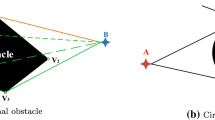Abstract
With the recent boom in unmanned aerial vehicle (UAV) technology, many UAV applications involving complex and risky tasks in military and civilian fields have emerged, such as military strikes and disaster monitoring. Task allocation for UAVs is the process of planning the division of work among UAVs, controlled from ground stations by human operators. This study formulates the UAV task-allocation problem as an extended traveling salesman problem and presents a novel UAV task-allocation model for complex air concentration monitoring tasks. Then, an optimized non-dominated sorting genetic algorithm III (NSGA-III) based on a twin-exclusion mechanism, hierarchical objective-domination operator, and segmented gene encoding (i.e., NSGA-III-TEHOD) is developed to solve complex task-allocation problems involving multiple UAVs, hierarchical objectives, obstacles, and ambient wind. The algorithm is tested in several simulations, and the results demonstrate that the new algorithm outperforms NSGA-III, non-dominated sorting genetic algorithm II (NSGA-II), and genetic algorithm (GA) in terms of efficiency of global convergence and early maturation prevention and is available for the hierarchical objective-optimization problems.
Similar content being viewed by others
References
GIESE S, CARR D, CHAHL J. Implications for unmanned systems research of military UAV mishap statistics [C]//2013 IEEE Intelligent Vehicles Symposium. Gold Coast, Australia: IEEE, 2013: 1191–1196.
WU J, ZHOU G. High-resolution planimetric mapping from UAV video for quick-response to natural disaster [C]//2006 IEEE International Symposium on Geoscience and Remote Sensing. Denver, CO, USA: IEEE, 2006: 3333–3336.
THIELS C A, AHO J M, ZIETLOW S P, et al. Use of unmanned aerial vehicles for medical product transport [J]. Air Medical Journal, 2015, 34(2): 104–108.
SHIMA T, RASMUSSEN S. UAV cooperative decision and control: Challenges and practical approaches [M]. Philadelphia, PA, USA: Society for Industrial and Applied Mathematics, 2009.
AGATZ N, BOUMAN P, SCHMIDT M. Optimization approaches for the traveling salesman problem with drone [J]. Transportation Science, 2018, 52(4): 965–981.
LIN J C, JIA G W, HOU Z X. Research on the task assignment of heterogeneous UAV formation in the anti-radar combat [C]//The 30th Chinese Control and Decision Conference (2018 CCDC). Shenyang, China: IEEE, 2018: 2028–2033.
VIVALDINI K C T, MARTINELLI T H, GUIZILINI V C, et al. UAV route planning for active disease classification [J]. Autonomous Robots, 2019, 43(5): 1137–1153.
BELLINGHAM J, TILLERSON M, RICHARDS A, et al. Multi-task allocation and path planning for cooperating UAVs [M]//Cooperative control: Models, applications and algorithms. Boston, MA, USA: Springer, 2003: 23–41.
WANG Z, LIU L, LONG T, et al. Multi-UAV reconnaissance task allocation for heterogeneous targets using an opposition-based genetic algorithm with double-chromosome encoding [J]. Chinese Journal of Aeronautics, 2018, 31(2): 339–350.
EDISON E, SHIMA T. Integrated task assignment and path optimization for cooperating uninhabited aerial vehicles using genetic algorithms [J]. Computers & Operations Research, 2011, 38: 340–356.
XU G T, LIU L, TENG L, et al. Cooperative multiple task assignment considering precedence constraints using multi-chromosome encoded genetic algorithm [C]//2018 AIAA Guidance, Navigation, and Control Conference. Kissimmee, Florida, USA: AIAA, 2018: 1859.
RAMIREZ-ATENCIA C, R-MORENO M D, CAMACHO D. Handling swarm of UAVs based on evolutionary multi-objective optimization [J]. Progress in Artificial Intelligence, 2017, 6(3): 263–274.
WEN T X, ZHANG Z N, WONG K K L. Multiobjective algorithm for blood supply via unmanned aerial vehicles to the wounded in an emergency situation [J]. PloS One, 2016, 11(5): e0155176.
ZITZLER E, KÜNZLI S. Indicator-based selection in multiobjective search [C]//International Conference on Parallel Problem Solving from Nature. Berlin, Germany: Springer, 2004: 832–842.
POHL A J, LAMONT G B. Multi-objective UAV mission planning using evolutionary computation [C]//Proceedings of the 40th Conference on Winter Simulation. Miami Florida, USA: IEEE, 2008: 1268–1279.
NIKOOFARD A H, HAJIMIRSADEGHI H, RAHIMIKIAN A, et al. Multiobjective invasive weed optimization: Application to analysis of Pareto improvement models in electricity markets [J]. Applied Soft Computing, 2012, 12: 100–112.
DEB K, PRATAP A, AGARWAL S, et al. A fast and elitist multiobjective genetic algorithm: NSGA-II [J]. IEEE Transactions on Evolutionary Computation, 2002, 6(2): 182–197.
RAMIREZ-ATENCIA C, CAMACHO D. Constrained multi-objective optimization for multi-UAV planning [J]. Journal of Ambient Intelligence and Humanized Computing, 2019, 10(6): 2467–2484.
ZITZLER E, LAUMANNS M, THIELE L. SPEA2: Improving the strength Pareto evolutionary algorithm [R]. Zurich, Switzerland: Swiss Federal Institute of Technology (ETH) Zurich, 2001.
DEB K, JAIN H. An evolutionary many-objective optimization algorithm using reference-point based non-dominated sorting approach, Part I: Solving problems with box constraints [J]. IEEE Transactions on Evolutionary Computation, 2014, 18(4): 577–601.
JAIN H, DEB K. An evolutionary many-objective optimization algorithm using reference-point based nondominated sorting approach, Part II: Handling constraints and extending to an adaptive approach [J]. IEEE Transactions on Evolutionary Computation, 2014, 18(4): 602–622.
CENSOR Y. Pareto optimality in multiobjective problems [J]. Applied Mathematics and Optimization, 1977, 4(1): 41–59.
LI J, SUN X X. A route planning’s method for unmanned aerial vehicles based on improved A-star algorithm [J]. Acta Armamentarii, 2008, 29(7): 788–792 (in Chinese).
TECHY L, WOOLSEY C A. Minimum-time path planning for unmanned aerial vehicles in steady uniform winds [J]. Journal of Guidance, Control, and Dynamics, 2009, 32(6): 1736–1746.
ODA T, BAROLLI A, XHAFA F, et al. WMN-GA: A simulation system for WMNs and its evaluation considering selection operators [J]. Journal of Ambient Intelligence and Humanized Computing, 2013, 4(3): 323–330.
Author information
Authors and Affiliations
Corresponding author
Additional information
Foundation item: the National Key Research and Development Program of China (No. 2017YFC0209902)
Rights and permissions
About this article
Cite this article
Jin, Y., Feng, J. & Zhang, W. UAV Task Allocation for Hierarchical Multiobjective Optimization in Complex Conditions Using Modified NSGA-III with Segmented Encoding. J. Shanghai Jiaotong Univ. (Sci.) 26, 431–445 (2021). https://doi.org/10.1007/s12204-021-2269-5
Received:
Accepted:
Published:
Issue Date:
DOI: https://doi.org/10.1007/s12204-021-2269-5
Key words
- unmanned aerial vehicle (UAV)
- task allocation
- non-dominated sorting genetic algorithm (NSGA)
- multiobjective optimization




